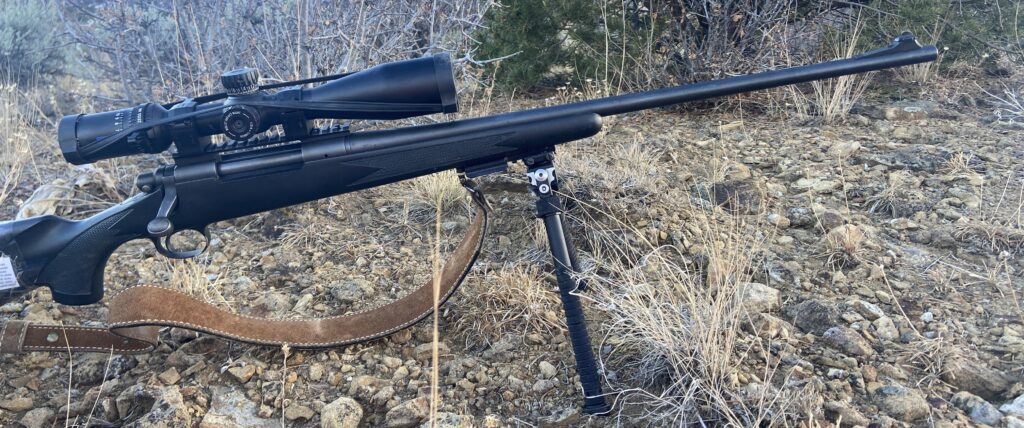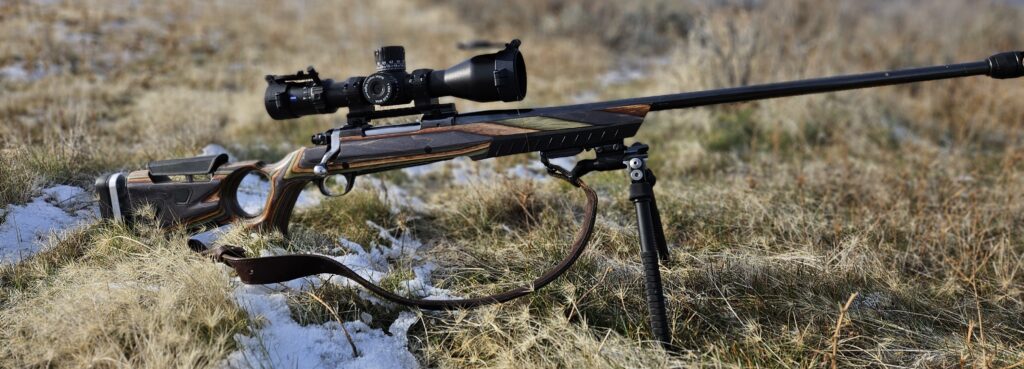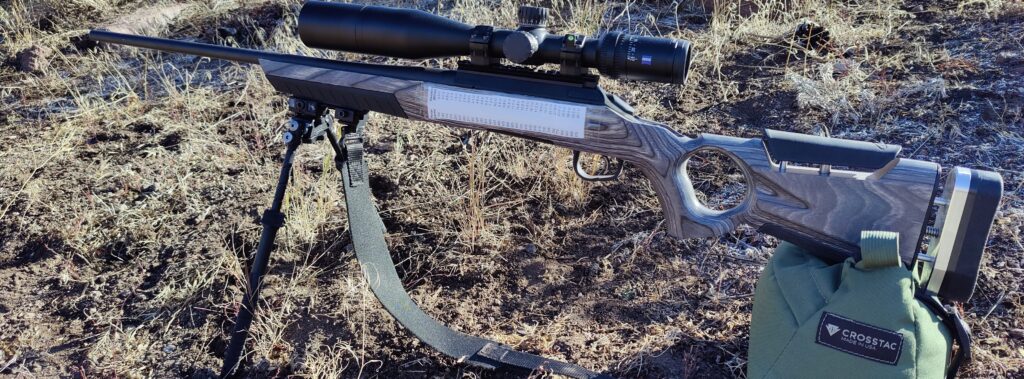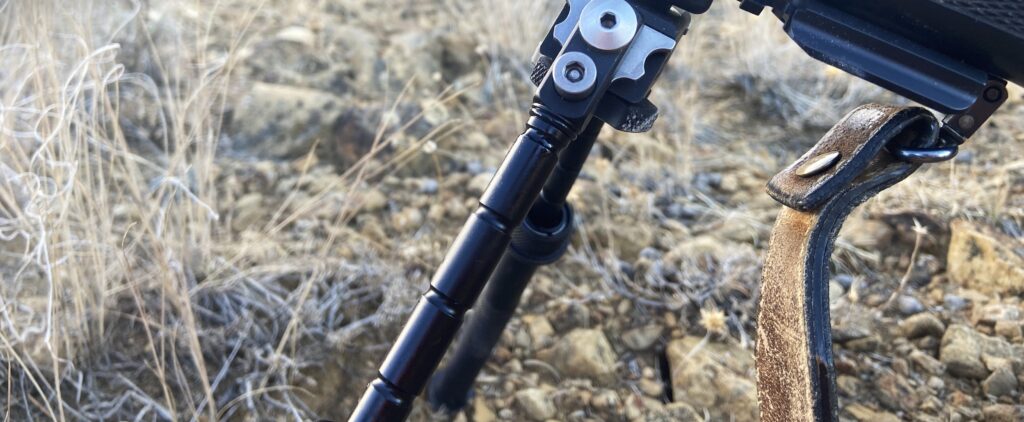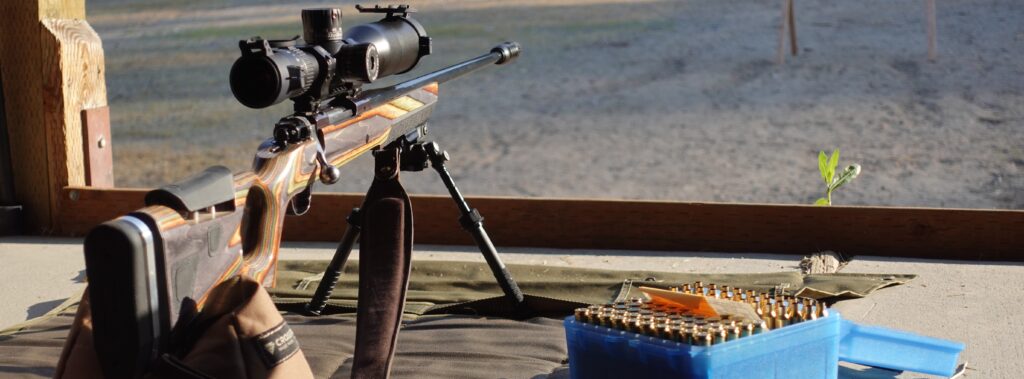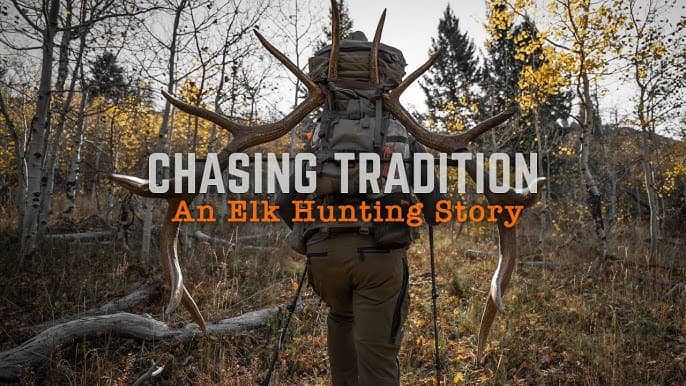While growing up in the Idaho backcountry, Atlas bipods weren’t even a thought in the back of our minds. I spent a lot of years tromping around the forest with my dad and brothers. We were very successful hunters, and it was rare for us to complete a hunting season without at least a couple of us filling a tag or two with our rifles. I remember well the first buck I shot with a Ruger 270. It was barely a legal buck, but being able to share that memory (along with lots of other hunting stories) with my young boys now has become almost a nightly bedtime routine.
I still remember trying to get set up for a shot on that mule deer buck. It was a downhill shot in sage, so I had to prop my rifle on an old external pack frame to try to get the right height and angle while shooting over the brush.
Over the years of hunting, I’ve taken a lot of shots in many different scenarios. Looking back, some of those shots were pretty ill-advised. Most of the time, those questionable shots were a combination of inexperience and being caught in a situation without a good rest for my rifle.
For years I relied on finding a good rock, tree stump, tree limb, or anything else solid to lean against to get a decent rest. While getting prone for a shot is clearly the most stable option, it’s often not possible because of the surrounding vegetation.
The first time I used a bipod was back in 2017 on a South Texas, free-range Aoudad hunt with a good buddy. We spotted a great ram about 1,500 yards away and started our stalk. We reached a ridgeline about 450 yards away, and he pinned us down. We had nowhere to go to get any closer. At this point in my life, I had heard of and seen bipods, but didn’t really want the extra weight on my rifle and didn’t see the value in buying one. After all, over the years I had done pretty well and been successful without one.
The terrain and angle of the shot on that ram made laying across my pack (as I had done many times before) a challenging option. I needed a touch of elevation to clear the vegetation, but my pack was too tall and contorted my body in a way that made me question whether I could execute an ethical shot.
My buddy handed me his rifle (with his bipod attached), we got the bipod set up for the height I needed, dialed and leveled the scope, called the wind and I squeezed the trigger. The shot felt good and was confirmed by my buddy a few moments later who saw that the ram was hit and going down.
I finally realized the value of a bipod. The speed at which we were able to set up on that ram was much faster and more effective than I’d ever been able to do laying across my pack and having to adjust it multiple times to get things right. Additionally, the stability I felt with the bipod (and good optics) made it feel like the ram was 200 yards away, not 450 yards. It was then that I understood and determined that the weight of a bipod is absolutely worth it.
Is A Bipod Needed For Backcountry Hunting?
As I mentioned above, for years I heard about bipods and just didn’t see the value in adding a bipod to my rifle setup. Ignorance was bliss. It wasn’t until I had a real-world experience with a bipod that put me “all in” on the bipod concept. The old saying of experience being the best teacher is true for me in this instance.
So, is a bipod critical for a backcountry hunt? The reality is that adding one of these Atlas bipods to your setup is a completely personal preference. I run across plenty of hunters that don’t give a bipod a second thought. On the other hand, I know plenty of guys that wouldn’t be caught dead in the hunting woods without it attached to their rifle.
All I can say is that, personally, I won’t be going hunting without a bipod on my gun. Since my first kill with a bipod, I’ve been able to take a handful of animals and be a part of a bunch of hunts where a bipod is definitely one of the big contributors to harvesting an animal.
The concern that I had about adding weight and bulk to my rifle setup is absolutely valid. Obviously, the more accessories you add to your rifle, the more weight you’ll be hauling up and down the mountain. For me, however, the trade off of stability, versatility, and improving my shooting ability are well worth the trade in weight.
My effective and comfortable range since adding a bipod to my rifle is another piece worth mentioning. Before shooting with a bipod, typically I would try to get within the 300-400 yard range for a shot. I just never seemed to be able to get stable enough to feel good about pulling the trigger on an animal outside of that range. Sure, I took some longer shots at the gun range, but that was off of sand bags and not in the field. I never really felt comfortable and steady enough to warrant shooting an animal beyond 400 yards.
Since adding this Atlas bipod to my rifle setup, along with upgrading my optics to the Zeiss Conquest V4 6-24×50, it has comfortably added a few hundred yards of range in the field. The stability that a bipod adds makes a shot in the backcountry feel like a shot at the range.
Now I will say that adding a bipod to your rifle isn’t a magic bullet that allows you to shoot a deer at 1,500 yards. It’s a tool that you have to learn how to use to make an ethical kill. My effective range has largely grown due to significantly more time at the range, calculating dope charts, understanding my ballistics and wind drift, and honing my shooting skills. The bipod is just a small piece of the puzzle.
Atlas Bipod Specs: V8 vs PSR vs Cal
Now let’s get into some of the specs of the these three Atlas bipods. There are a bunch of options for bipods as they come in about every size, shape, weight, attachment style, and design. My goal for my rifle is to keep the weight and bulk to a minimum while also having the ability to cant and pan once I get set up for a shot. Additionally, I wanted to have around 12” of elevation available in my bipod.
With that in mind, a few of us here at Backwoods Pursuit set out to test three different Atlas bipods to see which one would be the best fit for the backcountry hunter. The three we tested were the Atlas V8 BT10 Bipod, the Atlas PSR BT46 LW17, and the Atlas CAL BT65. Keep in mind that each or these series of bipods (V8, PSR, and CAL) have many mounting, height, and attachment options, but here are the specs for each of the respective bipods that we tested:
| V8 BT10 | PSR BT46-LW17 | Cal BT69 | |
|---|---|---|---|
| Weight | 11 oz | 13.61 oz | 14.48 oz |
| Min Height | 4.8″ | 5.2″ | 6.1″ |
| Max Height | 9.1″ | 9.6″ | 12.3″ |
| Pan | 30° (15° each way) | 30° (15° each way) | No |
| Cant | 30° (15° each way) | 30° (15° each way) | 63° (31.5° each way) |
| Leg positions | 5 independent positions (0, 45, 90, 135 & 180 degrees) | 5 independent positions (0, 45, 90, 135 & 180 degrees) | 5 independent positions (0, 45, 90, 135 & 180 degrees) |
| Mounting Options | No Clamp, Quick Release, Picatinny, ARMS17S, ARCA | No Clamp, Quick Release, Picatinny, ARMS17S, ARCA | No Clamp, Quick Release, Picatinny, ARMS17S, ARCA |
| Leg extensions | 3” extensions available (1.8 oz) | 3” extensions available (1.8 oz) | 3” extensions available (1.8 oz) |
Atlas Bipod Features: V8 vs PSR vs Cal
There are a lot of options out there when you are looking at these Atlas bipods. The range and style of bipod you need will be determined by how you plan to use it, your budget, and the level of precision you’re looking for. For me, weight and size were two of my main factors when I was looking at adding a bipod to my rifle.
These Atlas bipods have some great features that I felt covered the multitude of situations I was going to face in the backcountry. Here is a list of the features:
- UHMW components used for smooth tracking
- Pre-load on Pan and Cant can be tightened by means of the knurled knob
- Mounting Options: Picatinny Rail Mount (quick release or standard screw fastener), ARMS 17S lever mount
- Independent, intentional and non-orientated leg positioning allows either hand to move leg into any of the five leg positions
- Solid leg positions allow the shooter to load the bipod at the 45 and 90 degree positions.
- Non-orientated leg length adjustment done by either hand: Outer leg slides on the inner leg locating on any of five positions ¾” apart
- Standard soft, durable rubber feet that are suitable for many surfaces included
- Optional 3” leg extensions to increase height
- Optional interchangeable ski feet and raider cleat feet easily swapped in the field with the press of a stainless steel plunger
- Optional mounting systems available for Accuracy International and Sako rifles
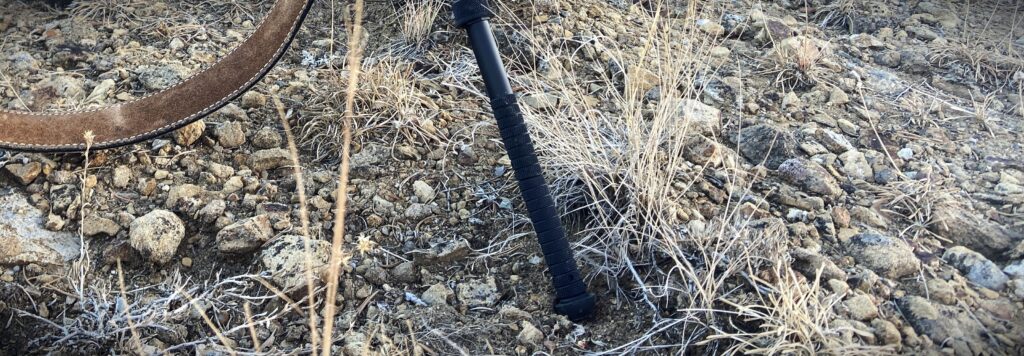
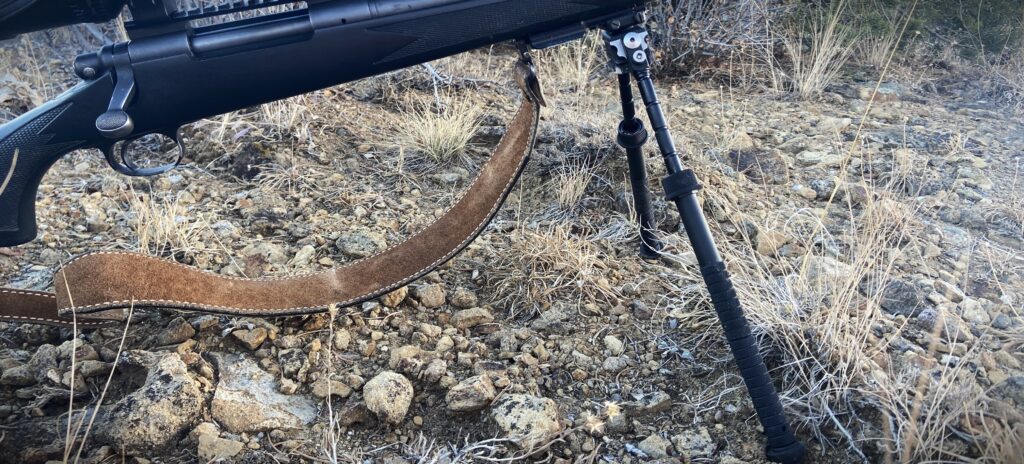
We built out one of these Atlas bipods with the traditional picatinny rail mount interface (the Atlas V8 and Cal), then selected the quick release picatinny clamp for the PSR bipod. We don’t typically plan on removing the bipods during hunting season but wanted to try the different options. We also added the Atlas BT22 3” leg extensions to get a bit more height out of them for hunting situations.
ADJUSTING THE LEGS – ATLAS BIPODS
All of the Atlas bipods have the same leg adjustments, and we found the adjustments to be extremely convenient and quick. The adjustments can be made on both the height of the bipod to elevate the rifle as well as having five solid leg positions/angles that allow the legs to move from 0 degrees forward, or almost parallel with the barrel of your rifle, to 45 degrees forward, 90 degrees straight down, 45 degrees back and 0 degrees folded all the way back.
When in the 45 and 90 degree positions, the bipod allows you to “load” the bipod as well. The adjustment for changing these positions is simply a push button that allows you to move each leg independently to the next position. Once you release the button in your desired position, it is solid and won’t unintentionally move on you.
Additionally, I really like the design of the height adjustment of the Atlas bipod legs. The height adjustment is an internal leg extension that is released, or moved by compressing the upper part of the leg and pulling down on the exterior portion of the leg. The height is adjustable in ¾” increments up to an additional 4.25 inches fully extended, and the legs can be adjusted independently of each other. With the Atlas BT22 3” leg extenders I was able to have 7.75” to 12” of height on this Atlas V8 BT10, 8.2” to 12.6” with the PSR BT46, and 7.9” to 12.2” with the CAL BT65.
I really like the ability to have multiple leg angles and height positions that can be changed independently of each other. If you find yourself in a position where you need to make a shot on uneven ground, the ability to not only adjust the height of each leg, but also the angle, is really helpful.
PAN AND CANT – ATLAS BIPODS
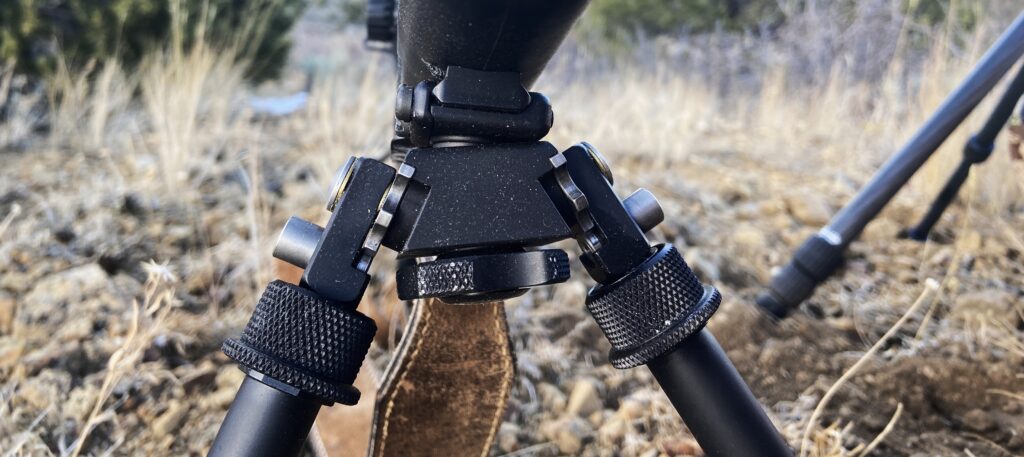
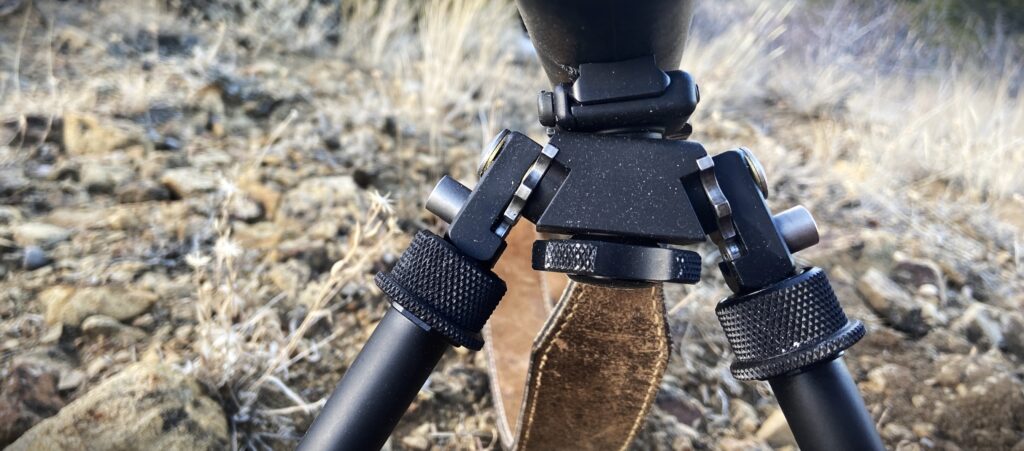
One additional function to consider in a bipod is whether it has pan and/or cant functionality. The PSR and the V8 give you both, while the CAL only offers cant. With the PSR and V8 the pan function gives you 15 degrees of movement to the left and 15 degrees of movement to the right for a total of 30 degrees of pan. This function is important to me when picking a bipod because it seems rare that I have been able to get set up for a shot without having an animal move slightly before pulling the trigger.
Having the ability to track with a deer that is walking without having to adjust the feet of the Atlas bipod is huge. That being said, it is far less important to the hunter than having the ability to cant. While using the Atlas CAL bipod does not offer the Pan feature, it is not detrimental but would be nice to have.
The ability of the Atlas bipod to cant is of the utmost importance for any hunting rifle as it allows you to level your rifle for the shot. While that may not be detrimental for shots under 200 yards, once ranges start to extend, it is absolutely critical to making a quality shot. Backing up, the cant (or tilt) function is what allows for your rifle to tilt to one side or the other and level your rifle in the uneven terrain we often hunt in.
All three of these Atlas bipods give you the ability to cant your rifle, with the Atlas PSR and V8 offering 15 degrees of cant to the right and 15 degrees of cant to the left (30° total), while the CAL gives you a whopping 31.5° to the right and left (63° total). They both give you the ability to tighten the cant down to set the amount of resistance depending on your needs and the weight of your rifle.
Again, the ability of a bipod to cant was critical for me when looking at which model I wanted to put on my rifle. Western big game hunting throws a lot of different situations at us, and we are typically not on level terrain. Being able to get my rifle level on uneven ground is a critical part of making an ethical shot.
What I liked: Atlas Bipods
As with most reviews, after testing a product for a period of time it gives us a chance to discuss the aspects that we like, along with what we think could be improved. I’ll start with the best aspects of the Atlas bipods.
WEIGHT – Atlas Bipods
As I mentioned above, there were a few components of a bipod that were on the top of my priority list. The first thing I looked at was the weight of the bipod. For me, all of these Atlas bipods hit the mark on what I was looking for in the weight category based on how much weight I was willing to add to my rifle.
Now, there are certainly lighter options out there vs these Atlas bipods such as the MTN Gear, a Backlanz Precision Alpine, and Spartan Precision Javelin, but as is always the case, there is a sacrifice in stability. For me, the Atlas bipods coming in at a total of 12.8 oz, 15.4 oz, and 13.7 oz (which includes the 3” leg extensions) was well within reason for me given the stability you get.
COMPACT – Atlas Bipods
Atlas bipods are pretty compact when mounted on a rifle. Again, not the MOST compact on the market, but certainly far from bulky. To my surprise, the bulk of adding the bipod to my rifle didn’t really bother me at all. They have designed it in a way that makes it hug against the stock and up towards the barrel of a rifle so that it stays out of the way while in the field.
PAN AND CANT – Atlas Bipods
Another aspect of this bipod that I liked was the pan and cant features. Having the ability to make finite adjustments on uneven ground while set up on a target that moves makes for a much easier and smoother shot process than having to reset every time your target takes a few steps. While the Atlas CAL does not offer the same pan feature as the PSR and V8, it does offer more stability than the PSR and V8 due to its wider stance. It’s a tradeoff, but after using both in the field, I wouldn’t hesitate to use the Atlas CAL out hunting as the extra stability is noticeable.
USE OF LEGS – Atlas Bipods
Additionally, I found that using the legs, whether I needed to extend one or adjust the angle, was very user friendly. Being able to independently adjust them at different heights and angles was very useful.
PRICE POINT – Atlas Bipods
Lastly, the price point of these Atlas bipods V is not so outrageous that you have to take out a second mortgage on your home. For the quality and features of this bipod, the cost is pretty reasonable, particularly given the price point of other similar bipods on the market today.
What I disliked: Atlas Bipods
While using these Atlas bipods there wasn’t a lot to complain about, but there was one thing that I found could use some improvement.
STICKY CANT
After putting quite a few rounds through my rifle using each of these bipods, I found the cant to be a bit sticky at times. This made fine tuning the cant to get the rifle perfectly level a bit tedious at times. Ideally, having a smoother adjustment would be the goal. Regardless of whether I loosened the cant knob as much as possible or tightened it down, it seemed to stick a bit. It wasn’t a major deal, and I was able to get level, but it took a little more work at times than I would like.
Conclusion: Atlas Bipod Review
In conclusion, I am a big fan of these Atlas bipods. They fulfilled everything I was looking for in a bipod without breaking the bank. The pros definitely outweigh the cons, and I feel like these bipods make you a better shooter by adding the extra level of stability and adjustment that is needed whether at the range as an avid shooter or in a real life, backcountry hunting situation. They are well-built and do not feel flimsy at all. If you’re considering adding a bipod to your rifle setup, or are just looking for an upgrade, I would definitely consider one of these Atlas bipods.
Make sure to check out our other gear reviews and the Backwoods Pursuit YouTube Channel to help you decide what gear will help you stay out in the field longer!
Subscribe to Backwoods Pursuit to get Your FREE Backcountry Gear Worksheet!!!
Dial in your gear list, calculate your pack weight, and lighten up your pack with this handy tool!



